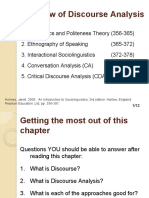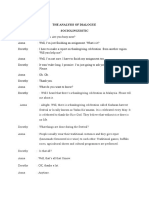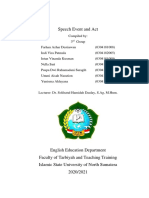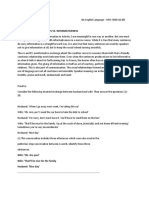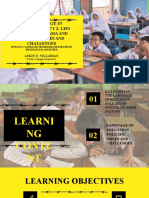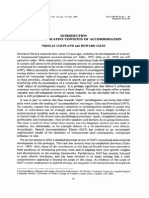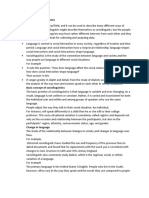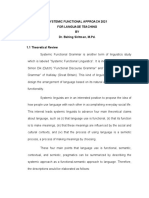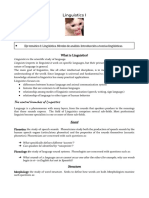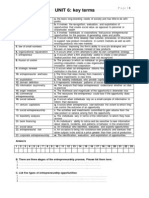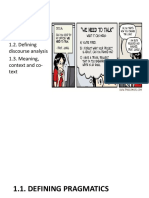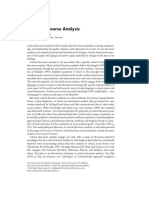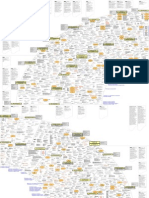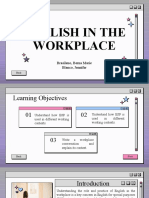ROYAL UNIVERSITY OF PHNOM PENH INSTITUTE OF FOREIGN LANGUAGES Department of English
MA (TESOL)
INTRODUCTION TO APPLIED LINGUISTICS
Lecturer Presenter
Dr. OUK Diven TE Vannarath
�Discourse Analysis
By Michael McCarthy Christian Matthiessen Diana Slade
In the book An Introduction to Applied Linguistics Edited by Norbert Schmitt
�What is Discourse Analysis?
Life is a constant flow of discourse.
Together, the discourses make up a culture. Language learners are demanded to learn how to
engage in discourse. The study of discourse is absolutely central to the concerns of applied linguistics. Both language learners and teachers learn to attend to the different strands of patterning in discourse and understand the contexts and linguistic strategies most immediately relevant.
�What is Discourse Analysis?
The discourse analyst studies authentic texts
(spoken/written, long/short) and is interested the relationship between the texts and the contexts in which they arise and operate. Discourse analysts work with utterances while grammarians work with sentences. Discourse analysts focus on:
-Who are the participants in the discourse? -How do we know what writers and speakers mean?
�What is discourse analysis?
�What are the benefits of discourse analysis?
�What is Discourse Analysis?
Analyzing the discourse helps language teachers and
material writers to evaluate language course books. -How closely they approximate authentic language -what needs to be modified when authentic texts are used in the classroom -a source of test criteria
�Speaking and Writing
If the main focus is on written language, spoken
language is seen as formless and ungrammatical. Based the analysis of spoken discourse, spoken English does have a consistent and describable structure (pauses, repetitions and false starts).
Informal spoken English Formal written English
Casual conversation
Email to friends
Letter to an acquaintance
Job interview
Written academic article
�Speaking and Writing
Casual conversations closeness
Academic texts detachment Spoken and written discourse have different lexical
density. Spoken discourse has a far lower lexical density . Both spoken and written language have structures and patterns. Halliday stated : talking and writing, then, are different ways of saying. They are different modes for expressing linguistic meanings.
�Approaches to Discourse Analysis
- Overview
Discourse analysts come from a
number of different academic disciplines. The approaches that are relevant to applied linguistics and language education, according to disciplinary origins are - Sociology conversation analysis - Sociolinguistics Ethography, Interactional sociolinguistics, Variation theory
�Approaches to Discourse Analysis
- Overview
- Philosophy Speech act theory, Pragmatics - Linguistics Structuralfunctional, Social semiotic - Artificial intelligence
�Approaches to Discourse Analysis
-
Conversation analysis is concerned
Overview - Sociology: Conversation Analysis
with the detailed organisation of everyday interaction. Key questions are: How do people take turns in conversation? How do people open and close conversations? How people launch new topics, close old ones, shift topic, etc.? How is it that conversation generally progresses satisfactorily from one utterance to the next?
�Approaches to Discourse Analysis
-
Conversation analysts are
Overview - Sociology: Conversation Analysis -Turn-taking
interested in how speakers achieve smooth turn-taking, and what the rules are for who speaks when. Expressions used to take turn: If I may ask a question.. Can I speak?... Back-channel responses: Mmm, uhuh, yeah, sure, listeners show that they are following.
�Approaches to Discourse Analysis
-
Another important aspect of turn-
Overview - Sociology: Conversation Analysis -Turn-taking
taking is the way interlocutors predict one anothers turns. Patterns in turn-taking: Adjacency pairs, solidary routines, converging pairs
�Sociolinguistic Approaches: Ethnography and variation theory
Anthropological linguistics and
sociolinguistics are concerned with studying not the isolated sentence but how language creates effective communication in the contexts of everyday life.
�Sociolinguistic Approaches: Ethnography and variation theory
-
Concerned with the situation and
Ethnography
uses, the patterns and functions, of speaking as an activity in its own right. Speech events: conversation at a party, The concept of genre
�Sociolinguistic Approaches: Ethnography and variation theory
-
Developed by Labov (1972)
Interested in structures of spoken
Ethnography
Variation theory
narratives Abstract Orientation Complication Evaluation Resolution Coda
�Sociolinguistic Approaches: Ethnography and variation theory
-
Typical response of pupils to
Ethnography
Variation theory
Linguistic Approaches
teachers questions Discourse markers: now then, right T: How do we use a thermometer? Jennie. (Initiating move) S: Put it in your mouth. (Responding move) T: You put it in your mouth. (Follow-up move)
�Sociolinguistic Approaches: Ethnography and variation theory
-
Describing the relationship of
Ethnography
Variation theory
Linguistic Approaches Systemic Functional Linguistics
language , text, and social life Aiming at explaining the nature and organisation of language The central concern is how people use language with each other to accomplish social life and how social worlds are created in and through language.
�Sociolinguistic Approaches: Ethnography and variation theory
-
Concerned with the relationship
Ethnography
Variation theory
Linguistic Approaches Systemic Functional Linguistics Critical Discourse Analysis
between language, ideology, and power; and the relationship between discourse and sociocultural change See genres as both social and textual categories
�Grammar and Discourse: Spoken and Written Differences
In written discourse, readers
process the texts in a logical and commonsence way. The subject is not repeated. Listeners always know what is being referred. In spoken discourse, countable nouns occur without articles, statements without subjects,
�Lexical Patterns in Spoken Language
Interested in how speakers and
writers use of lexis creates patterns over longer stretches of text beyond the sentence Listeners repeats the speakers lexis. The use of synonyms Repetition and relexicalization enable conversational participants to converge on meanings, to negotiate them in particular contexts.
�Implications for Pedagogy
Describe how language is structured in different
contexts of use Model different types of writing Raise awareness of the nature of teacher-learner interaction Evaluate learners performance Encourage authenticity Provide guidelines for the use of language
�Discussion Questions
Why do we, EFL teachers, have to analyze discourse?
Differentiate between spoken discourse and written
discourse.






